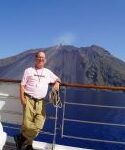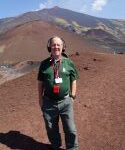Smoking hot at Etna
August 9, 2017
Heat has followed us this whole trip; it’s been in the upper 90s every day. Rome, after all, has been hotter than New Delhi.
But I awoke to a new “heat” this morning—we’re docked off Mount Etna, the largest and most active volcano in Europe.
Some of the most famous volcanos are in Italy, part of the “belt of fire” that extends east from here into Turkey. Etna is probably the best known certainly other than Vesuvius, which in 79 AD buried Pompeii. We’ll see that in a few days, too. There’s also a potentially devastating explosion waiting to happen in Naples from a “young volcano.”
The trip took us to 6000 of the 11,000 feet (and to temperate temperatures, thankfully). The mountain is obviously the highest thing around, and rises from sea level.

 We stopped at the site of an explosion in the mid 19th century, I believe, which left a variety of cones (big cones are caldera, usually where the explosion collapsed the area). Our guide told us that the cone explodes gas and ash, and the lava flows come from fissures; usually the fissures are a one-time phenomenon. Sometimes the cone will throw larger stones, called bombs. He showed us a variety of the rocks, from the dust and ash to the lava.
We stopped at the site of an explosion in the mid 19th century, I believe, which left a variety of cones (big cones are caldera, usually where the explosion collapsed the area). Our guide told us that the cone explodes gas and ash, and the lava flows come from fissures; usually the fissures are a one-time phenomenon. Sometimes the cone will throw larger stones, called bombs. He showed us a variety of the rocks, from the dust and ash to the lava.

 We drove later to a lava flow, dating from the early 1990s. He explained how the lava flow perpetuates itself; as the upper layer cools and solidifies the lower layers stay warm (over 2500 degrees) and flow underneath, eventually breaking through and resuming their flow until eventually cooling and generally stopping. In the case of this particular lava flow, the nearby US Air Force base sent in helicopters with bombs to alter the path (kind of like setting counter fires). It’s on youtube, and I do have to say that seeing the explosions and flows (we had a talk afterwards on the boat with visuals) are pretty spectacular. We’ll have other chances—the island of Stromboli, and later, Vesuvius and the Pompeii ruins.
We drove later to a lava flow, dating from the early 1990s. He explained how the lava flow perpetuates itself; as the upper layer cools and solidifies the lower layers stay warm (over 2500 degrees) and flow underneath, eventually breaking through and resuming their flow until eventually cooling and generally stopping. In the case of this particular lava flow, the nearby US Air Force base sent in helicopters with bombs to alter the path (kind of like setting counter fires). It’s on youtube, and I do have to say that seeing the explosions and flows (we had a talk afterwards on the boat with visuals) are pretty spectacular. We’ll have other chances—the island of Stromboli, and later, Vesuvius and the Pompeii ruins.
The boat talk was by a government agent who’s part of the monitoring of “momma Etna,” which once had the traditional cone shape I associate with volcanoes (Fujiyama anyone?), but in the 20th century has gotten new craters—including “big mouth” (a more colorful name than South East) and the eruption of new craters has continued in 20th century—even in the past year, new craters have emerged, a phenomenon never observed this quickly anywhere else in the world. He said explosions can be violent, with fragments of ash and gas which are blown downwind and ash covers everything. I remember when St. Helens blew in the ’80s, we had to wipe off ash from our cars. Here in Italy, he said, cleanup is slow. Dust can spread and make visibility difficult, roads slippery, and air bad to breathe. Lots of “hills” we saw were baby craters at lower elevations. A 1669 eruption reached 10 km, down to the sea.
When we asked him about living in a volcanic area, he noted that only one of the modern explosions threatened a city on the slope, and the slow progress of lava took 5 weeks to reach the village, allowing everyone to move anything they wanted—except their houses. Interestingly, there’s no volcano insurance available in Italy, though there are some government funds.
He said the “heat of pyroclastic (look that up in your dictionary) flows killed people in Pompeii,” not the explosion, which is a product of the water vapor buildup from the intense heat. Other gases include carbon dioxide and sulphur oxide, which can leave a residue of yellow on the top of the mountain, looking at first glance like snow.
In all, it might have been smoking hot, but it was a pretty cool experience!